For nearly a decade, North Carolina has seen a steep decline in its public education funding commitments resulting in declining student academic performance. The state is ranked 42nd for per-pupil spending, over $3,000 less than the national average.1 North Carolina’s National Assessment of Educational Progress (NAEP) scores reveal that student achievement has stagnated across all subjects after decades of improvement.2 Additionally, the state continues to see growing achievement gaps between white students and students of color.3 The harm of inadequate funding is disproportionately severe for English Learning students who face additional barriers to opportunity.4
Despite these obstacles, there are countless examples across the state that point to promising interventions that can help ensure more equitable outcomes for English learners. As children of immigrant families become increasingly central to our social and economic future, North Carolina has the opportunity to create inclusive, academically high performing learning environments for all children.
This brief provides an overview of the state’s obligation to meet the needs of English learners, how limited funding exacerbates the opportunity gap,5 and highlights practices and policies that can ensure every child receive an education free from barriers to academic achievement.
Supporting English Learning students is not just a good idea: it’s the law
State and federal laws require school districts to ensure all children, regardless of their native language, have the opportunity to succeed.
FEDERAL LAWS PROTECT ENGLISH LEARNERS AND THEIR FAMILIES
At the federal level, Title VI of the Civil Rights Act of 1964, the 1965 Elementary and Secondary Education Act, and the Bilingual Education Act of 1968 secure basic education rights for English learners. These federal statutes create obligations for state and local entities to ensure English learners receive adequate resources and services to overcome language-based barriers to a sound education.
More recently, the federal Every Student Succeeds Act of 2015 requires states to report more information about English learners’ academic progress and to demonstrate efforts to advance local stakeholder engagement on behalf of these students.6
Legal precedent has been set throughout the past several decades requiring that English learners be offered a range of rights, services and accommodations, including:
- Segregation prohibited: Menendez v. Westminster (1946) held that the practice of segregating English learner students into separate schools was unconstitutional.
- Language access required: Lau v. Nichols (1974) held that school districts must take steps to guarantee English learners can comprehend the material and curricula being taught. This ruling led to the creation of guidelines for teaching English learners, including the requirement that instruction be offered in languages that they can comprehend.
- High-Quality language acquisition programs required: Castaneda v. Pickard (1978) required school districts to offer evaluated and proven English language acquisition programs.
- Undocumented students have the right to an education: Plyler v. Doe (1982) held that all children residing in the United States, regardless of immigration status, have the right to free elementary and secondary education.7
STATE OBLIGATIONS UNDER LEANDRO V. STATE
The North Carolina Supreme Court’s landmark ruling in Leandro v. State sets out the constitutional obligations for educating all students. This ruling establishes that all children residing in the state have a fundamental right to the “opportunity to receive a sound basic education” and that the responsibility for guaranteeing that right lies with the State of North Carolina rather than with local school districts. Funding gaps and entrenched economic disparities across communities create inequalities that deny opportunities to certain students, inequalities that the state is responsible for remedying. Leandro defines subgroups of “at-risk” students by having any of six distinct characteristics,8 including limited proficiency in English.
North Carolina Is Failing Its Obligations to English Learners
Despite the state’s constitutional obligation to ensure an equal education to all students, funding and support for effective educational programming has been inadequate and inequitable. 9 Local school districts receive the majority of their funding through the state’s allotment system, primarily through three central sources:
- “Base funding” amounts which provide a set amount to support all students
- “Student characteristic” funding, which provides additional amounts to support a school district’s specific student needs such as Exceptional Children, students with low incomes, and English Learning students
- Additionally, districts can access “district-based” funding, which is primarily directed at low-wealth districts where adequate local revenue sources are absent10
Schools use a combination of these funds (as well as local and federal funding) to provide services and supports for English learners. However, the main source of direct state support for English learners is a specific “student characteristic” allotment known as the Limited English Proficiency (LEP) allotment. Many of the specific allotments addressing “student characteristic” needs were devised and capped without being adjusted to reflect population growth, linguistic diversity or evolving student needs. Rural school districts tend to rely more heavily on state and federal funding given the limitations on local revenue capacity,11 making it even more difficult to provide needed supports and services.
The LEP allotment stands out from other funding streams in that a district must have at least 20 ELs, or at least 2.5 percent of their students, to be eligible. The LEP allotment is the only student
characteristic allotment that contains such a minimum eligibility threshold. As a result, five school
districts were denied any supplemental funding for English learners in FY 2017-2018.12 In addition to the threshold, the allotment funding is capped at 10.6 percent of a district’s total student headcount. Due to the cap, another 13 school districts have a greater concentration of EL students than the formula captures, resulting in LEP funding that does not match the level of need in these districts. Each district with at least 20 English learners receives the dollar equivalent of one teacher assistant position. Any remaining funds are allocated 50 percent the number of English learners and 50 percent of the concentration of English learners.13 Unfortunately, the current state budget for education reflects an inconsistent and incomplete investment in the LEP allotment.
Adding to the barrier of insufficient funding support available via the LEP allotment is the state’s overall trend in declining per-pupil investment, which contributes to a larger funding shortfall of $994 million affecting spending on total allotments since 2009.14
In guaranteeing a sound, basic education for all children, the state must adequately fund the LEP allotment in order to meet the needs of a growing and linguistically diverse student population. The arbitrary cap must be lifted and the funding formula itself be evaluated. Additionally, the LEP allotment could be a strategic tool in addressing the state’s teacher diversity problem by allowing districts to provide salary supplements to attract and retain bilingual teachers.15
English learners’ academic outcomes are reflective of their unmet academic as well as social emotional needs, as seen in cuts to per-pupil spending as well as supports and services such as Teachers Assistants, certified counselors, psychologists, nurses, social workers and librarians, classroom materials, instructional aids, and professional development training.
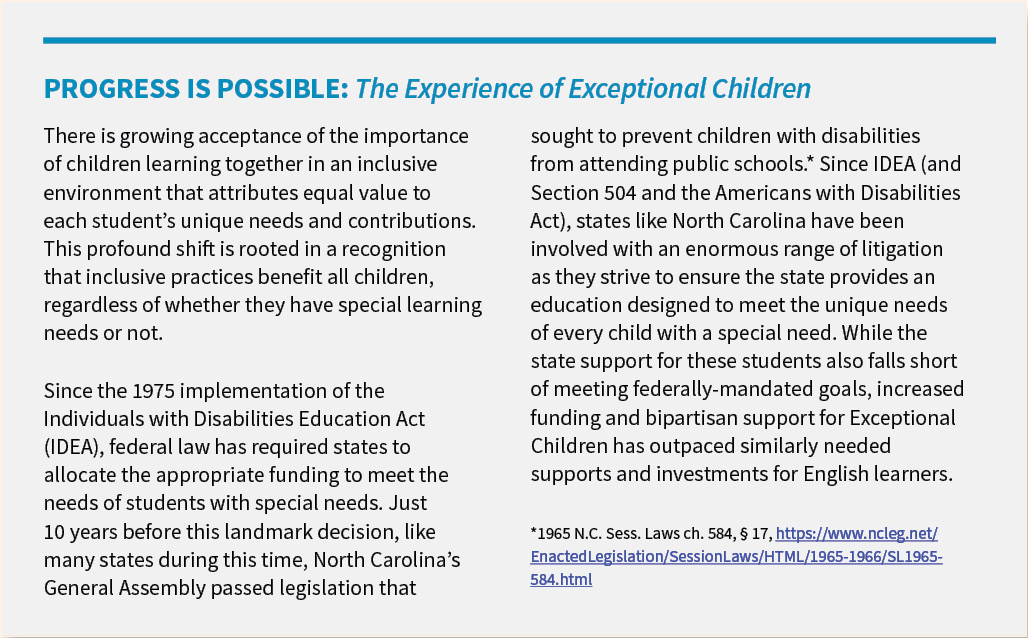
THE SCHOOL INSTRUCTIONAL SUPPORT STAFF FUNDING CRISIS AND ITS EFFECT ON ENGLISH LEARNERS
Over the last decade, state investment has fallen for instructional support staff by over 9 percent.
- The National Association of School Psychologists recommends school districts employ one psychologist for every 500 to 700 students; in North Carolina, current funding allows for just one psychologist for every 2,008 students
- The recommended ratio for School Counselors is one for every 250 students; North Carolina employs one counselor for every 367 students
- North Carolina nurses serve an average of 1,112 students, 48 percent more students than the federally recommended ratio of 1 nurse per 750 students.16
- The recommendation for School Social Workers is one for every 250 students; North Carolina’s ratio is one for every 2,000 students17
Considering the unique mental health needs of children of immigrants and their families, the harm
caused by inadequate school support staff funding is disproportionately severe. Research around
childhood trauma, known as Adverse Childhood Experiences (ACEs), is increasingly informing the way school systems understand their students’ mental health needs; however, they are limited by severe staffing shortages, particularly a shortage of bilingual and culturally competent school staff. ACEs are traumatic events that can have long-term negative effects on health and well-being. Examples of ACEs that may be prevalent among children of immigrants include economic insecurity and family separation.18
The full estimated amount of necessary funding to bring North Carolina school support staffing up to at least the nationally recognized industry standards would require doubling the state’s existing funding levels.19 This does not account for the need for bilingual support staff or cultural competency training.
NORTH CAROLINA’S ENDURING EDUCATIONAL OPPORTUNITY GAP
The vast majority of the 100,000 English learners in North Carolina are native born.20 North Carolina has one of the 10 largest English learner populations nationwide21 and was among five states that experienced the greatest growth in English learners between 2000-2014.22 Despite such growth, the state has not kept pace with the need to support and prepare school systems to ensure academic success for English learners.
North Carolina is failing to close the gap between English learners and their peers. In the 2016-2017 school year, only 28.7 percent of English learners achieved proficiency on the State Reading/Language Arts assessment by 3rd grade. English learners also faced unique barriers in achieving proficiency in third grade Mathematics, with just 48 percent proficient.23
English learners are also under-represented in Advanced and Intellectually Gifted (AIG) programs, largely due to language barriers and the lack of academic assessments offered in native languages.24 In North Carolina, less than 1 percent of English learners are enrolled in AIG programs, compared to 11 percent of non-English learning students.25
These disparities along the educational path lead to disturbingly glaring gaps in graduation rates. The graduation rate for English learners in North Carolina is among the worst in the country with just 58 percent of English learners graduating compared to the state’s total graduation rate of 86.5 percent.26
Many studies point to the positive correlation between teacher diversity and higher academic
achievement for students of color.27 North Carolina’s teacher workforce, similar to the national teacher profile, is predominately female and white. In a state where students of color make up 52 percent of the traditional school population, over 80 percent of its teachers are white. Unsurprisingly, many teachers lack the language skills and cultural competency to address diverse students’ needs, which can lead to additional barriers to full participation for both the student and family.
With inadequate funding available to support the needs of English learners, it should come as no surprise that they face unique challenges to academic achievement. In a context of insufficient state funding perpetuating achievement gaps, some school districts are taking steps to address the needs of their English learners and to break down academic barriers that undermine the educational experience for everyone, native English-speaking and English learners alike.
Practices Promoting Academic Achievement
Adequate funding is necessary but insufficient to ensure the success of all students. Closing achievement gaps requires the implementation of evidence-based practices that create inclusive educational environments that benefit all students, regardless of their native language. This section reviews practices that can support better academic outcomes for all students.
BEST PRACTICES IN ENGLISH LEARNING PROGRAMS
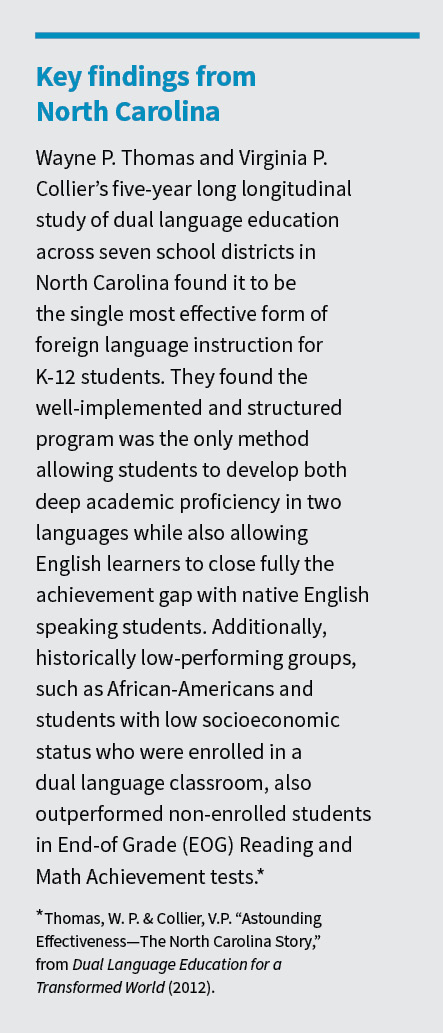
Federal law requires that districts identify English learners in a timely manner to ensure that schools are taking “appropriate action”28 to address student needs. Timely identification of English learners is the basis of a three-pronged test referred to as the Castañeda Standard, the result of a ruling outlining how schools must meet the requirements of the Equal Educational Opportunities Act of 1974 (EEOA) as it pertains to English learners. This test is the basis for assessing whether a school district’s English Learning program complies with federal law.
School districts identify English learners when it is determined that a language other than English is spoken in their homes. The district will then administer the Home Language Survey and, based on that result, the WIDA Screener assessment. The school will then determine the appropriate instructional delivery method.
While methods differ across districts and from school to school, we can assess them based on a range of practices known to either impede or advance inclusion. Most English learners in North Carolina receive traditional ‘pull-out’ English as a Second Language instruction (typically happening outside the traditional classroom) but spend the majority of the day in a classroom led
by a general education teacher who has likely not received the necessary training to address their needs. While programs vary widely even within a school district, a common challenge is inadequate instructional support to complement the ESL program. Structured English Immersion (SEI) is a program seeking to ease the transition into an English-only speaking classroom where a trained instructor is prepared to meet the unique needs of the English learners.
While ESL programs are the most common form of instruction in North Carolina, evidence from the state’s well-implemented and structured dual language immersion education programs (DL/Is) demonstrate this method as being the single most effective form of foreign language instruction for K-12 students. According to the NC Department of Instruction, there are currently more than 170 DL/I programs across all eight state regions, in 42 districts and six charter schools.29 North Carolina is an exemplary model of the academic benefits achieved by English Speaking and English Learning students enrolled in well-implemented, two-way dual language instruction programs. Such programs can be twice as effective in improving outcomes as reducing the size of traditional bilingual classes for English learners.
The collective findings from the 32-year, large-scale, longitudinal Thomas and Collier study30 reveal that dual-language programs are incredibly successful. Highlight19ed in their work is the case study from North Carolina which demonstrates that DL/Is are advancing academic outcomes for English learners as well as closing the achievement gap. The programs studied in North Carolina had been operating for at least four years and were part of six school districts: Chapel Hill-Carrboro City, Charlotte-Mecklenburg, Chatham County, Durham County, Greene County, and Winston-Salem/Forsyth County Schools. The study demonstrated that, ovcoerall, “Reading and Math scores of students in two-way dual language education are higher for all students regardless of race/ethnicity, socioeconomic, LEP or special education status. In most cases, by middle school, two-way dual language students, regardless of subgroup, are at least a grade ahead in Reading and Math achievement compared to non-dual language students.”31
Building upon the effectiveness of the state’s dual language education and the documented academic gains from DL/I programs,32 North Carolina can expand such opportunities by investing additional resources to current programs, and by encouraging programs to expand to include middle and high school offerings. While number of DL/I programs has grown in recent years, they still represent less than 7 percent of the state’s traditional public schools. The opening of the state’s first Urdu-English dual-language immersion program in Guilford County is a promising example of a community’s culturally responsive leadership in addressing the growing student population’s needs.33
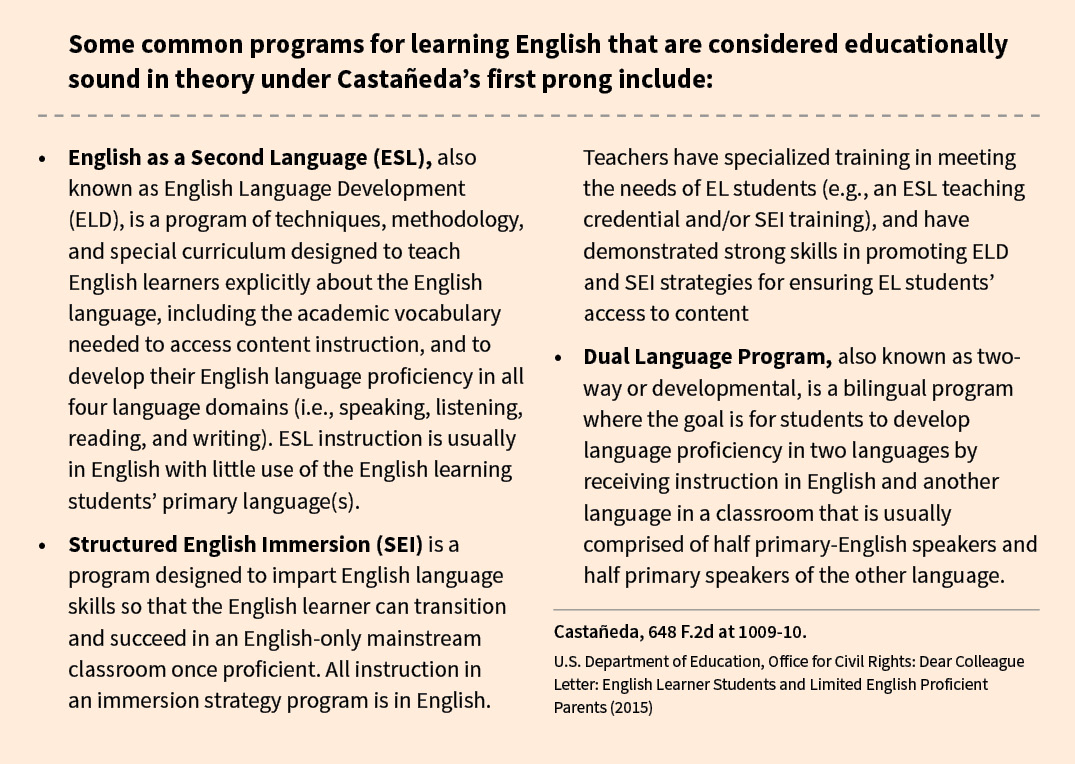
Language Access and Culturally Competent Approaches to Encourage Equitable Family Engagement
Strong school-family-community involvement is a critical component to a child’s academic and personal success,34 while creating and maintaining positive, inclusive school cultures is integral in ensuring consistent, active family engagement. Fostering a set of shared values is essential in demonstrating that the school community is committed to providing a welcoming and tolerant environment for all families, regardless of a family’s formal education, socioeconomic status, immigration status or native language. Linguistically diverse families are often barred entry to meaningful opportunities to engage with their child’s school due to language access barriers, racial, and cultural bias.35 There are numerous examples of successful and equitable family engagement across North Carolina. Rather than seeing a growing, diverse student and family population through a deficit36 mindset, such school communities are embracing inclusive strategies. Emphasizing culturally appropriate language access and positive school-family relationships that honor, welcome, and celebrate diversity are strategies to ensure academic success for all children.37
COMMUNITY SCHOOLS
The Community Schools approach38 seeks to reimagine the relationship between a school and its
surrounding community, transforming schools from providers of education into tools for addressing the full range of social and family conditions that influence students’ prospects. Research-based strategies are key components of the model:
- Engaging, culturally relevant, and challenging curricula
- An emphasis on high-quality teaching instead of high-stakes testing
- Wrap-around supports and opportunities
- Positive discipline practices, such as restorative justice
- Authentic parent and community engagement
- Inclusive school leadership39
The Community Schools model is rooted in four mechanisms for addressing the barriers that can
stand in the way of student success: as asset and needs assessment, the development of a strategic plan, engagement of key stakeholders and partners, and the placement of a Community Schools Coordinator.40
With this model, strategic partnerships are developed to integrate the needs and resources in both the school and greater community. When communities see schools as learning centers and responsively addressing the needs of its members, there will be more opportunities to transform deeply rooted challenges. Using this model, the school might be accessible to parents and family members seeking workforce development trainings, ESL classes, and counseling. The school may also house medical, dental, and mental-health services in order to eliminate barriers to care and improve academic outcomes for all students.
Additionally, the Community Schools model may include a focus on trauma-informed school practices, a strategy with heightened importance under an immigration policy climate that disproportionately targets the families of English learners. This is particularly important given the current funding shortfalls of school support staff, such as social workers, counselors, and nurses, as well as the additional needs of staffing bilingual support staff. With an increase in trauma-informed school practices,41 needs can be identified and appropriately addressed in a caring and inclusive environment.42
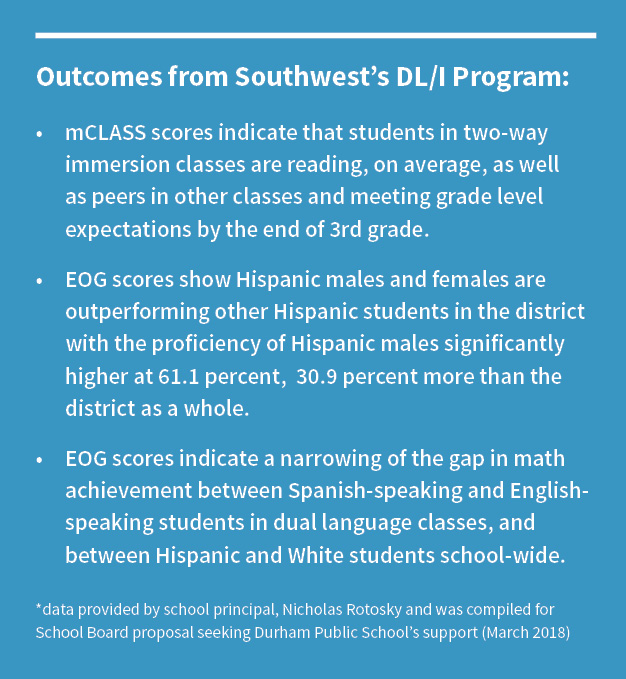 The Community School model presents a uniquely promising strategy to combine many of the practices known to improve academic outcomes for English learners. Part of the fundamental components of a well-designed and implemented Community Schools partnership include family and community engagement and culturally responsive delivery models. Evidence backed research is also demonstrating that, similar to the encouraging results from the dual-language programs in North Carolina, a well-implemented Community Schools model can both improve student outcomes and help close achievement gaps.43
The Community School model presents a uniquely promising strategy to combine many of the practices known to improve academic outcomes for English learners. Part of the fundamental components of a well-designed and implemented Community Schools partnership include family and community engagement and culturally responsive delivery models. Evidence backed research is also demonstrating that, similar to the encouraging results from the dual-language programs in North Carolina, a well-implemented Community Schools model can both improve student outcomes and help close achievement gaps.43
Two Community Schools initiatives44 in North Carolina may offer models for other districts: Asheville-Buncombe Middle Grades Network45 and the Bull City Community Schools Partnership46 in Durham Public Schools.47 Both seek to increase equity and inclusion as well as close the achievement gap.
One of the schools chosen to participate in Durham’s pilot year program48 is Southwest Elementary. Southwest’s DL/I programs has existed for over a decade and currently follows a 90/10 model. With this model, 90 percent of core instruction is in Spanish at the kindergarten level with the percentage of English language instruction increasing each year until it is a 50 percent English/50 percent Spanish balance by 3rd grade. Southwest has demonstrated consistent academic success with participating students outperforming their district counterparts in Math and Reading End-of-Grade (EOG) tests. In addition to academic achievement, the program incorporates a parent-to-parent paring initiative, which matches each English-speaking parent with a Spanish-speaking parent. This fosters a school-wide culture of inclusion and integration. Regular communication and language exchange is encouraged and facilitated via bilingual community meetings and cultural events at the school.
ESL PARENT LIAISON AND FAMILY ENGAGEMENT STAFF
Districts that employ an ESL Parent Liaison or comparable support staff are well positioned to address the specific needs of diverse families and English learners. Having a trained, bilingual liaison can help bridge the gap in communication between the school and home, and serve as an essential navigator to assist parents in understanding the system and ensuring their children have the opportunity to succeed. Additionally, districts can bolster meaningful and active family engagement by providing consistent, high quality interpretation and translation at school events, parent meetings, and School Board meetings.
Districts employing an ESL Parent Liaison can help build a strong and resilient extended school community by explicitly welcoming all families and ensuring their equal access to opportunity and fair treatment.49 All students, regardless of immigration status, have the right to enroll in any public school free from discrimination. Alarmingly, a Duke Children’s Law Clinic report revealed that about 60 percent of public school districts in North Carolina inhibited enrollment for immigrant students by requiring non-essential documentation and failing to make enrollment requirements accessible.50 Advocates rely on trusted parent-school liaisons to help report such violations, intervene on a student’s behalf, and educate district staff on the law and relevant rules and procedures.
Other programs that help foster inclusion and a positive integration into the school system are new family welcome orientations and Newcomer programs. The Doris Henderson Newcomers School in Greensboro helps ease the transition to an English-only traditional school by integrating content area subjects into ESL instruction.51
Conclusion
Progress requires holding leaders accountable for upholding the state constitutional obligation to provide a sound, basic education to all of our children. Through adequate funding, well designed and implemented instructional programs, and practices that foster equitable family engagement, North Carolina can remove academic barriers to education and meet the needs of its English learning students.
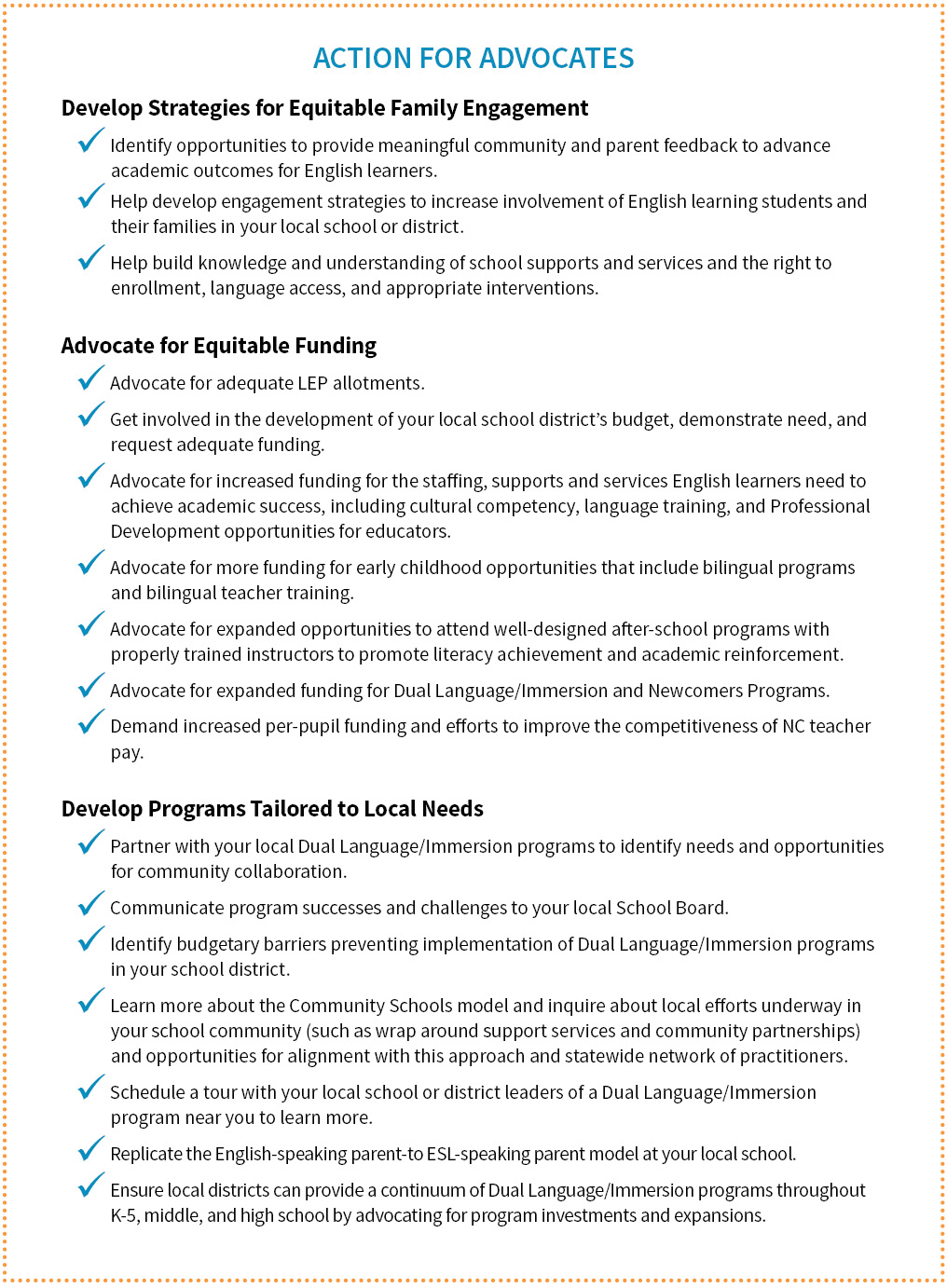
Footnotes
- National Education Association, “Rankings of the States 2017 & Estimates of School Statistics 2018.” http://www.nea.org/assets/
docs/2019%20Rankings%20and%20Estimates%20Report.pdf?_ga=2.11734644.150710434.1555261732-1201080585.1552276206 - https://www.nationsreportcard.gov/profiles/stateprofile/overview/NC
- https://hechingerreport.org/national-test-scores-reveal-a-decade-of-educational-stagnation/
- Referred to as Limited English Proficient Students under US DOE Title IX: See U.S. Department of Education Title IX- General Provisions (20 U.S.C. § 7801 et seq.) LIMITED ENGLISH PROFICIENT- The term limited English proficient’, when used with respect to an individual, means an individual — (A) who is aged 3 through 21; (B) who is enrolled or preparing to enroll in an elementary school or secondary school; (C)(i) who was not born in the United States or whose native language is a language other than English; (ii)(I) who is a Native American or Alaska Native, or a native resident of the outlying areas; and (II) who comes from an environment where a language other than English has had a significant impact on the individual’s level of English language proficiency; or
(iii) who is migratory, whose native language is a language other than English, and who comes from an environment where a language other than English is dominant; and (D) whose difficulties in speaking, reading, writing, or understanding the English language may be sufficient to deny the individual — (i) the ability to meet the State’s proficient level of achievement on State assessments described in section 1111(b)(3); (ii) the ability to successfully achieve in classrooms where the language of instruction is English; or (iii) the opportunity to participate fully in society. - http://schottfoundation.org/issues/opportunity-gap/talking-points
- For more, see: https://edtrust.org/students-cant-wait/english-language-proficiency/
- National Education Association, “All In! How Educators Can Advocate for English Language Learners” 2015. https://www.nea.org/assets/
docs/ADV104_DODSON_All_In_How_Educators_Can_Advocate_for_ELLs.pdf - The Court defined “at-risk” as students who: [are from] a low-income family; participate in free or reduced-cost lunch programs; have parents
with low-level education; show limited proficiency in English; are a member of racial or ethnic minority group; or live in a home headed by a
single parent or guardian. Hoke County Board of Education v. State, 358 N.C. 605, 632, 637 (2004) (“Leandro II”) - http://www.newsobserver.com/news/local/education/article204118229.html
- For more detailed explanation, see Kris Nordstrom’s “Financing Education in North Carolina: a Budget and Tax Guide” https://www.
ncjustice.org/publications/financing-education-in-north-carolina/ - https://www.ncforum.org/2019-local-school-finance-study/
- For FY 2016-2017 the following counties did not receive any LEP allotment funding: Camden County, Gates County, Weldon City, Pamlico
County and Swain County. https://www.ncleg.gov/documentsites/committees/BCCI-6685/Committee%20Meetings/1-31-18/NCASA_
NCSchoolFundingFormulaReport.pdf - Education Commission of the States, http://ecs.force.com/mbdata/mbstcprofexc?Rep=ELP14&st=North%20Carolina November 2014.
- http://pulse.ncpolicywatch.org/2018/05/30/legislatures-education-budget-highlights-continued-under-investment-in-publicschools/
- Kris Nordstrom, “Effective and Equitable: Creating a Shared Vision for North Carolina Schools,” as found at: https://www.ncjustice.org/wpcontent/
uploads/2019/04/EFFECTIVE-and-EQUITABLE-Shared-Vision-for-NC-SchoolsWEB.pdf#page=14 - https://publichealth.nc.gov/wch/aboutus/schoolnurses.htm
- https://governor.nc.gov/news/events/2019/01/17/january-17-2019-commission-access-sound-basic-education/january-17-2019
- Sacks, Vanessa, David Murphey and Kristin Moore, July 2014. Adverse Childhood Experiences: National and State Level Practice. Child Trends,
Washington, DC. https://www.childtrends.org/wp-content/uploads/2014/07/Brief-adverse-childhood-experiences_FINAL.pdf - Kris Nordstrom, “Effective and Equitable: Creating a Shared Vision for North Carolina Schools,” as found at: https://www.ncjustice.org/wpcontent/
uploads/2019/04/EFFECTIVE-and-EQUITABLE-Shared-Vision-for-NC-SchoolsWEB.pdf#page=9 - Sugarman, Julie and Kevin Lee, “Facts about English Learners and NCLB/ESSA Transition in North Carolina,” Migration Policy Institute, March
2017. https://www.migrationpolicy.org/research/facts-about-english-learners-and-nclb-essa-transition-select-states - https://www.migrationpolicy.org/research/states-and-districts-highest-number-and-share-english-language-learners
- https://www.migrationpolicy.org/programs/ell-information-center
- NC Department of Public Instruction, Accountability and Testing Results, 2016-2017 and NC Department of Public Instruction, Four Year
Cohort Graduation Rate. http://www.ncpublicschools.org/accountability/reporting/ - No assessments offered in native language. Consolidated State Performance Report: Parts I and II, North Carolina Department of Education:
For reporting on School Year 2016-2017. http://www.ncpublicschools.org/docs/data/management/federal-reports/cspr/2016-17/part2.
pdf - NPR analysis of Department of Education data Credit: Brittany Mayes and Lisa Charlotte Rost/NPR
https://www.npr.org/sections/ed/2017/02/23/512451228/5-million-english-language-learners-a-vast-pool-of-talent-at-risk - Source: NC DPI, Cohort Graduation Rate. Available at http://accrpt.ncpublicschools.org/app/2017/cgr/
- See Ford, James E. “Teaching-in-Color” series as found at: https://www.ednc.org/2018/03/26/teaching-in-color-teachers-telling-theirown-
stories/ - “appropriate action” as required by Castañeda v. Pickard §1703(f) requires that a school district’s language plan: 1. must be based on (a) a sound educational theory that is (b) supported by some qualified experts; 2. must be provided with sufficient resources and personnel to be implemented effectively; and 3. after a trial period, students must actually be learning English and, to some extent, subject matter content.
- 2018-2019 list of DL/I programs in North Carolina: https://sites.google.com/dpi.nc.gov/ncdli
- http://www.thomasandcollier.com/assets/aral-2017-(typed).pdf
- Thomas, W. P. & Collier, V.P. “English Leaners in North Carolina, 2010,” George Mason University. https://sites.google.com/dpi.nc.gov/ncdli/resources/thomas-collier-research
- https://www.edweek.org/ew/section/multimedia/dual-language-test-scores.html
- http://wunc.org/post/guilford-county-schools-offer-urdu-english-and-spanish-english-dual-language-programs#stream/0
- “Parent, Family, Community Involvement in Education.” An NEA policy brief, 2008. http://www.nea.org/assets/docs/PB11_
ParentInvolvement08.pdf - Teaching Tolerance, “Critical Practices for Anti-bias Education,” as found at: https://www.tolerance.org/magazine/publications/criticalpractices-
for-antibias-education - Shernaz B. Garcia, Patricia L. Guerra, “Deconstructing Deficit Thinking: Working with Educators to Create More Equitable Learning
Environments,” Feb. 2004, as found at: http://citeseerx.ist.psu.edu/viewdoc/download?doi=10.1.1.923.2705&rep=rep1&type=pdf - State Support Network, “Strategies for Equitable Family Engagement,” Dec 2018, as found at: https://statesupportnetwork.ed.gov/system/
files/equitable_family_engag_508.pdf
- http://www.communityschools.org/assets/1/Page/Community-School%20Standards-2017.pdf
- “Community Schools: Transforming Struggling Schools into Thriving Schools,” The Center for Popular Democracy, Coalition for Community
Schools, Southern Education Foundation: February 2016. https://populardemocracy.org/sites/default/files/Community-Schools-
Layout_e.pdf - For more information, see: http://www.communityschools.org/assets/1/AssetManager/Community%20School%20Models2009.pdf and
https://learningpolicyinstitute.org/product/community-schools-effective-school-improvement-brief - https://www.ncforum.org/committee-on-trauma-learning/
- For more background and context, see Alexandra Sirota’s “The ACE of ICE” https://www.ncjustice.org/publications/the-ace-of-ice-howcurrent-
immigration-enforcement-and-deportation-hurts-children/ - Maier, A, Daniel, J., Oakes, J. & Lam, L. (2017). Community schools as an effective school improvement strategy: A review of the evidence. Palo
Alto, CA: Learning Policy Institute. https://learningpolicyinstitute.org/sites/default/files/product-files/Community_Schools_Effective_
REPORT.pdf - While the Community Schools model mirrors many of the same goals and approaches as the network of “Communities in Schools” nonprofits,
it is important to note that they are different initiatives. - https://www.unitedwayabc.org/community-schools-asheville
- https://daenc.com/2018/04/04/community-schools-defend-and-transform-in-practice/
- https://daenc.com/2018/04/04/community-schools-defend-and-transform-in-practice/
- https://www.dpsnc.net/cms/lib/NC01911152/Centricity/Domain/77/Resolution%20in%20Support%20of%20Community%20Schools%20Initiative%20in%20Durham–Final%20approved%203.8.18.pdf
- For more background and recommendations, see Tyler Whittenberg’s “Language Barrier: Overcoming Obstacles for English Language
Learners in North Carolina” https://www.ncjustice.org/publications/language-barrier-overcoming-obstacles-for-english-languagelearners/ - Children’s Law Clinic, Duke University School of Law “Welcoming Immigrant Children to School: A Report of North Carolina School Districts,”
August 2017. https://law.duke.edu/childedlaw/docs/Immigration_Report_NC.pdf - https://ncela.ed.gov/files/feature_topics/newcomers/ElevatingELs_ProgramsForNewcomerStudents.pdf
 Justice Circle
Justice Circle